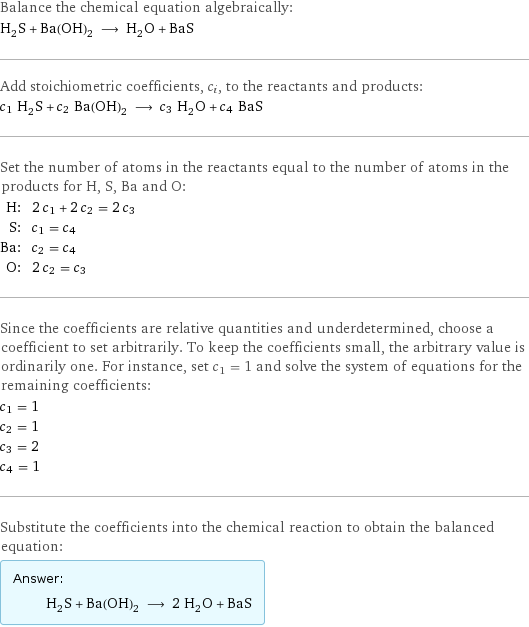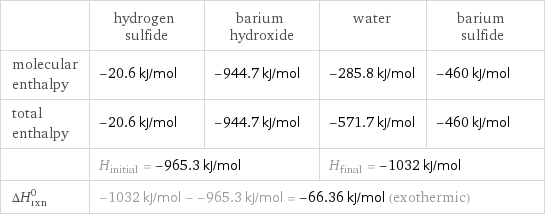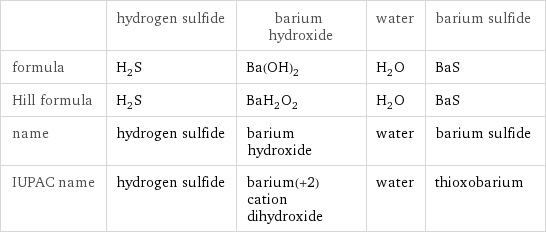Input interpretation

H_2S hydrogen sulfide + Ba(OH)_2 barium hydroxide ⟶ H_2O water + BaS barium sulfide
Balanced equation

Balance the chemical equation algebraically: H_2S + Ba(OH)_2 ⟶ H_2O + BaS Add stoichiometric coefficients, c_i, to the reactants and products: c_1 H_2S + c_2 Ba(OH)_2 ⟶ c_3 H_2O + c_4 BaS Set the number of atoms in the reactants equal to the number of atoms in the products for H, S, Ba and O: H: | 2 c_1 + 2 c_2 = 2 c_3 S: | c_1 = c_4 Ba: | c_2 = c_4 O: | 2 c_2 = c_3 Since the coefficients are relative quantities and underdetermined, choose a coefficient to set arbitrarily. To keep the coefficients small, the arbitrary value is ordinarily one. For instance, set c_1 = 1 and solve the system of equations for the remaining coefficients: c_1 = 1 c_2 = 1 c_3 = 2 c_4 = 1 Substitute the coefficients into the chemical reaction to obtain the balanced equation: Answer: | | H_2S + Ba(OH)_2 ⟶ 2 H_2O + BaS
Structures

+ ⟶ +
Names

hydrogen sulfide + barium hydroxide ⟶ water + barium sulfide
Reaction thermodynamics
Enthalpy

| hydrogen sulfide | barium hydroxide | water | barium sulfide molecular enthalpy | -20.6 kJ/mol | -944.7 kJ/mol | -285.8 kJ/mol | -460 kJ/mol total enthalpy | -20.6 kJ/mol | -944.7 kJ/mol | -571.7 kJ/mol | -460 kJ/mol | H_initial = -965.3 kJ/mol | | H_final = -1032 kJ/mol | ΔH_rxn^0 | -1032 kJ/mol - -965.3 kJ/mol = -66.36 kJ/mol (exothermic) | | |
Equilibrium constant
![Construct the equilibrium constant, K, expression for: H_2S + Ba(OH)_2 ⟶ H_2O + BaS Plan: • Balance the chemical equation. • Determine the stoichiometric numbers. • Assemble the activity expression for each chemical species. • Use the activity expressions to build the equilibrium constant expression. Write the balanced chemical equation: H_2S + Ba(OH)_2 ⟶ 2 H_2O + BaS Assign stoichiometric numbers, ν_i, using the stoichiometric coefficients, c_i, from the balanced chemical equation in the following manner: ν_i = -c_i for reactants and ν_i = c_i for products: chemical species | c_i | ν_i H_2S | 1 | -1 Ba(OH)_2 | 1 | -1 H_2O | 2 | 2 BaS | 1 | 1 Assemble the activity expressions accounting for the state of matter and ν_i: chemical species | c_i | ν_i | activity expression H_2S | 1 | -1 | ([H2S])^(-1) Ba(OH)_2 | 1 | -1 | ([Ba(OH)2])^(-1) H_2O | 2 | 2 | ([H2O])^2 BaS | 1 | 1 | [BaS] The equilibrium constant symbol in the concentration basis is: K_c Mulitply the activity expressions to arrive at the K_c expression: Answer: | | K_c = ([H2S])^(-1) ([Ba(OH)2])^(-1) ([H2O])^2 [BaS] = (([H2O])^2 [BaS])/([H2S] [Ba(OH)2])](../image_source/d7649a26bdeb547b09592853a198a607.png)
Construct the equilibrium constant, K, expression for: H_2S + Ba(OH)_2 ⟶ H_2O + BaS Plan: • Balance the chemical equation. • Determine the stoichiometric numbers. • Assemble the activity expression for each chemical species. • Use the activity expressions to build the equilibrium constant expression. Write the balanced chemical equation: H_2S + Ba(OH)_2 ⟶ 2 H_2O + BaS Assign stoichiometric numbers, ν_i, using the stoichiometric coefficients, c_i, from the balanced chemical equation in the following manner: ν_i = -c_i for reactants and ν_i = c_i for products: chemical species | c_i | ν_i H_2S | 1 | -1 Ba(OH)_2 | 1 | -1 H_2O | 2 | 2 BaS | 1 | 1 Assemble the activity expressions accounting for the state of matter and ν_i: chemical species | c_i | ν_i | activity expression H_2S | 1 | -1 | ([H2S])^(-1) Ba(OH)_2 | 1 | -1 | ([Ba(OH)2])^(-1) H_2O | 2 | 2 | ([H2O])^2 BaS | 1 | 1 | [BaS] The equilibrium constant symbol in the concentration basis is: K_c Mulitply the activity expressions to arrive at the K_c expression: Answer: | | K_c = ([H2S])^(-1) ([Ba(OH)2])^(-1) ([H2O])^2 [BaS] = (([H2O])^2 [BaS])/([H2S] [Ba(OH)2])
Rate of reaction
![Construct the rate of reaction expression for: H_2S + Ba(OH)_2 ⟶ H_2O + BaS Plan: • Balance the chemical equation. • Determine the stoichiometric numbers. • Assemble the rate term for each chemical species. • Write the rate of reaction expression. Write the balanced chemical equation: H_2S + Ba(OH)_2 ⟶ 2 H_2O + BaS Assign stoichiometric numbers, ν_i, using the stoichiometric coefficients, c_i, from the balanced chemical equation in the following manner: ν_i = -c_i for reactants and ν_i = c_i for products: chemical species | c_i | ν_i H_2S | 1 | -1 Ba(OH)_2 | 1 | -1 H_2O | 2 | 2 BaS | 1 | 1 The rate term for each chemical species, B_i, is 1/ν_i(Δ[B_i])/(Δt) where [B_i] is the amount concentration and t is time: chemical species | c_i | ν_i | rate term H_2S | 1 | -1 | -(Δ[H2S])/(Δt) Ba(OH)_2 | 1 | -1 | -(Δ[Ba(OH)2])/(Δt) H_2O | 2 | 2 | 1/2 (Δ[H2O])/(Δt) BaS | 1 | 1 | (Δ[BaS])/(Δt) (for infinitesimal rate of change, replace Δ with d) Set the rate terms equal to each other to arrive at the rate expression: Answer: | | rate = -(Δ[H2S])/(Δt) = -(Δ[Ba(OH)2])/(Δt) = 1/2 (Δ[H2O])/(Δt) = (Δ[BaS])/(Δt) (assuming constant volume and no accumulation of intermediates or side products)](../image_source/2c13d6c841fb25ac3433b3fe180c9a90.png)
Construct the rate of reaction expression for: H_2S + Ba(OH)_2 ⟶ H_2O + BaS Plan: • Balance the chemical equation. • Determine the stoichiometric numbers. • Assemble the rate term for each chemical species. • Write the rate of reaction expression. Write the balanced chemical equation: H_2S + Ba(OH)_2 ⟶ 2 H_2O + BaS Assign stoichiometric numbers, ν_i, using the stoichiometric coefficients, c_i, from the balanced chemical equation in the following manner: ν_i = -c_i for reactants and ν_i = c_i for products: chemical species | c_i | ν_i H_2S | 1 | -1 Ba(OH)_2 | 1 | -1 H_2O | 2 | 2 BaS | 1 | 1 The rate term for each chemical species, B_i, is 1/ν_i(Δ[B_i])/(Δt) where [B_i] is the amount concentration and t is time: chemical species | c_i | ν_i | rate term H_2S | 1 | -1 | -(Δ[H2S])/(Δt) Ba(OH)_2 | 1 | -1 | -(Δ[Ba(OH)2])/(Δt) H_2O | 2 | 2 | 1/2 (Δ[H2O])/(Δt) BaS | 1 | 1 | (Δ[BaS])/(Δt) (for infinitesimal rate of change, replace Δ with d) Set the rate terms equal to each other to arrive at the rate expression: Answer: | | rate = -(Δ[H2S])/(Δt) = -(Δ[Ba(OH)2])/(Δt) = 1/2 (Δ[H2O])/(Δt) = (Δ[BaS])/(Δt) (assuming constant volume and no accumulation of intermediates or side products)
Chemical names and formulas

| hydrogen sulfide | barium hydroxide | water | barium sulfide formula | H_2S | Ba(OH)_2 | H_2O | BaS Hill formula | H_2S | BaH_2O_2 | H_2O | BaS name | hydrogen sulfide | barium hydroxide | water | barium sulfide IUPAC name | hydrogen sulfide | barium(+2) cation dihydroxide | water | thioxobarium